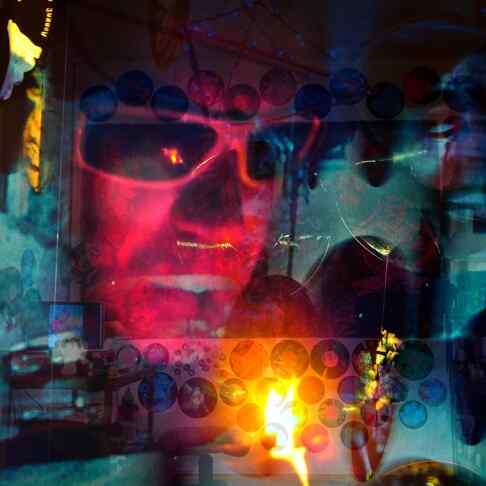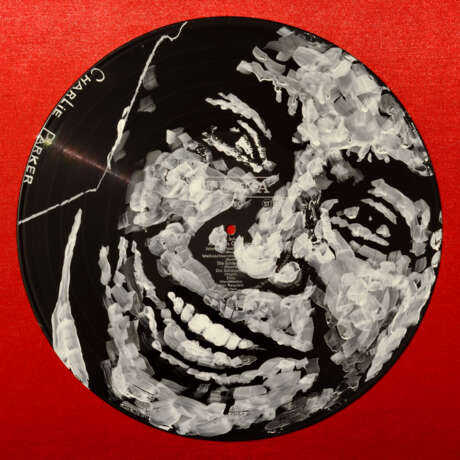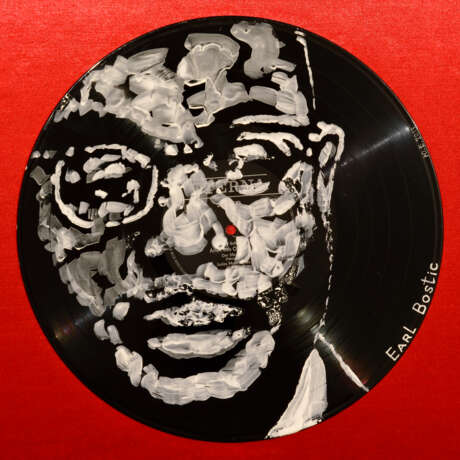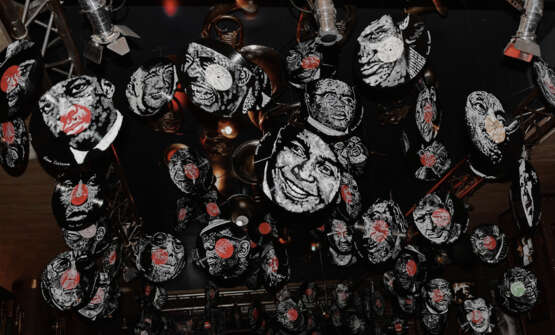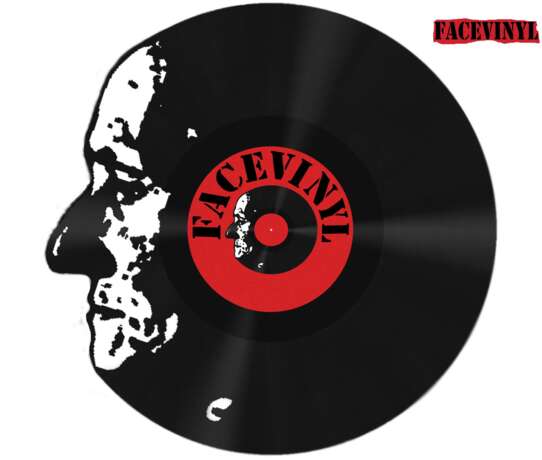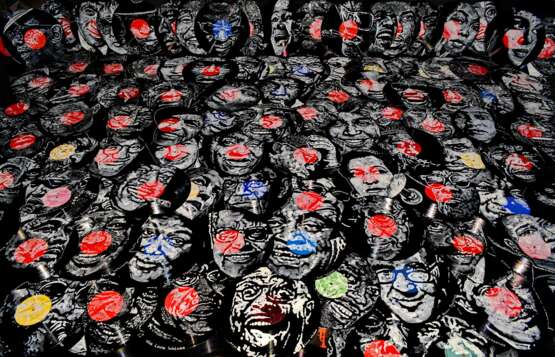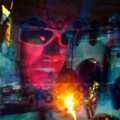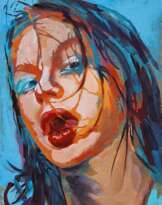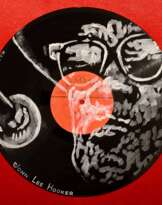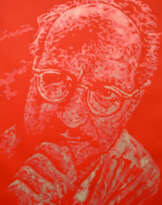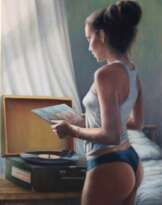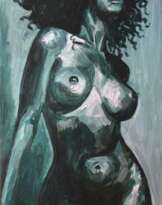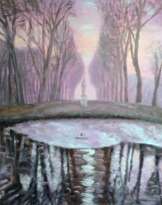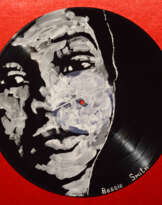Charlie Parker & Earl Bostic Acrylmalerei Moderne Kunst 2013
Yury Ermolenko, ''Charlie Parker'' - Facevinyl - THE BIG COLLECTION - №12, side I, 2013, acrylic on vinyl. The History of Jazz and Blues.
Yury Ermolenko, ''Earl Bostic'' - Facevinyl - THE BIG COLLECTION - №12, side II, 2013, acrylic on vinyl. The History of Jazz and Blues.
Charles Parker Jr. (August 29, 1920 – March 12, 1955), also known as Yardbird and Bird, was an American jazz saxophonist and composer.
Parker was a highly influential jazz soloist and a leading figure in the development of bebop, a form of jazz characterized by fast tempos, virtuosic technique and advanced harmonies. Parker was a blazingly fast virtuoso, and he introduced revolutionary harmonic ideas including rapid passing chords, new variants of altered chords, and chord substitutions. His tone ranged from clean and penetrating to sweet and somber. Parker acquired the nickname "Yardbird" early in his career on the road with Jay McShann. This, and the shortened form "Bird", continued to be used for the rest of his life, inspiring the titles of a number of Parker compositions, such as "Yardbird Suite", "Ornithology", "Bird Gets the Worm", and "Bird of Paradise". Parker was an icon for the hipster subculture and later the Beat Generation, personifying the jazz musician as an uncompromising artist and intellectual rather than just an entertainer. Parker's style of composition involved interpolation of original melodies over existing jazz forms and standards, a practice known as contrafact and still common in jazz today. Examples include "Ornithology" (which borrows the chord progression of jazz standard "How High the Moon" and is said to be co-written with trumpet player Little Benny Harris), and "Moose The Mooche" (one of many Parker compositions based on the chord progression of "I Got Rhythm"). The practice was not uncommon prior to bebop, but it became a signature of the movement as artists began to move away from arranging popular standards and toward composing their own material.
Eugene Earl Bostic (April 25, 1913 – October 28, 1965) was an American jazz alto saxophonist and a pioneer of the post-war American rhythm and blues style. He had a number of popular hits such as "Flamingo", "Harlem Nocturne", "Temptation", "Sleep", "Special Delivery Stomp" and "Where or When", which all showed off his characteristic growl on the horn.
Bostic was influenced by Sidney Bechet and (according to James Moody) John Coltrane was in turn influenced by Bostic. Coltrane told Down Beat magazine in 1960 that Bostic "showed me a lot of things on my horn. He has fabulous technical facilities on his instrument and knows many a trick." Moody mentioned that "Bostic knew his instrument inside out, back to front and upside down." If one listens carefully to Bostic's fabulous stop time choruses and his extended solo work, the roots of Coltrane's "sheets of sound" become clear.
Bostic's early jazz solos bear similarity to Benny Carter's long flowing lines. Other influences on Bostic include European concert music, bebop and the sounds associated with his Oklahoma roots. Bostic admitted that he was interested in selling records and he went as far as to write out his popular solos note for note in order to please his admiring fans during concerts. Nonetheless, Bostic was always ready to improvise brilliantly during his live performances.
Yury Ermolenko, ''Earl Bostic'' - Facevinyl - THE BIG COLLECTION - №12, side II, 2013, acrylic on vinyl. The History of Jazz and Blues.
Charles Parker Jr. (August 29, 1920 – March 12, 1955), also known as Yardbird and Bird, was an American jazz saxophonist and composer.
Parker was a highly influential jazz soloist and a leading figure in the development of bebop, a form of jazz characterized by fast tempos, virtuosic technique and advanced harmonies. Parker was a blazingly fast virtuoso, and he introduced revolutionary harmonic ideas including rapid passing chords, new variants of altered chords, and chord substitutions. His tone ranged from clean and penetrating to sweet and somber. Parker acquired the nickname "Yardbird" early in his career on the road with Jay McShann. This, and the shortened form "Bird", continued to be used for the rest of his life, inspiring the titles of a number of Parker compositions, such as "Yardbird Suite", "Ornithology", "Bird Gets the Worm", and "Bird of Paradise". Parker was an icon for the hipster subculture and later the Beat Generation, personifying the jazz musician as an uncompromising artist and intellectual rather than just an entertainer. Parker's style of composition involved interpolation of original melodies over existing jazz forms and standards, a practice known as contrafact and still common in jazz today. Examples include "Ornithology" (which borrows the chord progression of jazz standard "How High the Moon" and is said to be co-written with trumpet player Little Benny Harris), and "Moose The Mooche" (one of many Parker compositions based on the chord progression of "I Got Rhythm"). The practice was not uncommon prior to bebop, but it became a signature of the movement as artists began to move away from arranging popular standards and toward composing their own material.
Eugene Earl Bostic (April 25, 1913 – October 28, 1965) was an American jazz alto saxophonist and a pioneer of the post-war American rhythm and blues style. He had a number of popular hits such as "Flamingo", "Harlem Nocturne", "Temptation", "Sleep", "Special Delivery Stomp" and "Where or When", which all showed off his characteristic growl on the horn.
Bostic was influenced by Sidney Bechet and (according to James Moody) John Coltrane was in turn influenced by Bostic. Coltrane told Down Beat magazine in 1960 that Bostic "showed me a lot of things on my horn. He has fabulous technical facilities on his instrument and knows many a trick." Moody mentioned that "Bostic knew his instrument inside out, back to front and upside down." If one listens carefully to Bostic's fabulous stop time choruses and his extended solo work, the roots of Coltrane's "sheets of sound" become clear.
Bostic's early jazz solos bear similarity to Benny Carter's long flowing lines. Other influences on Bostic include European concert music, bebop and the sounds associated with his Oklahoma roots. Bostic admitted that he was interested in selling records and he went as far as to write out his popular solos note for note in order to please his admiring fans during concerts. Nonetheless, Bostic was always ready to improvise brilliantly during his live performances.
| ID: | 17244 |
|---|---|
| Künstler: | Yurii Yermolenko (geb. 1973) |
| Originalität: | Original |
| Zustand: | Neu |
| Herstellungsjahr: | 2013 |
| Angewandte Technik: | Siehe Beschreibung, Acrylmalerei |
| Größe: | 30 x 30 x 0.2 cm |
| Rahmung: | Ungerahmt |
| Kunst Stil: | Moderne Kunst |
Informationen zum Künstler
